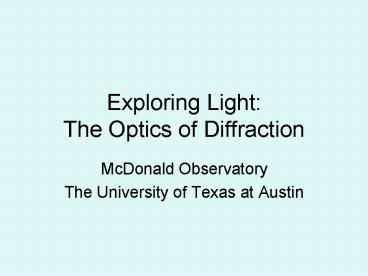Exploring Light: The Optics of Diffraction PowerPoint PPT Presentation
Title: Exploring Light: The Optics of Diffraction
1
Exploring LightThe Optics of Diffraction
- McDonald Observatory
- The University of Texas at Austin
2
Diffraction Activity Annex
Predict what happens to the waves as they pass
the barrier.
3
The waves bend around the barrier.
4
Interference
5
One hole
6
Predict pattern for two holes
7
(No Transcript)
8
(No Transcript)
9
Diffraction materials card
10
Seeing Diffraction
11
This shows the setup of the laser pointer shining
at the Diffraction Materials Card that is taped
to the edge of a table. The diffracted laser spot
is projected on the far wall.
12
This shows a close-up of the projected laser beam
with the setup laid out in the previous Annex
slide. The diffracted spots are clearly visible.
Projected on a piece of white paper, the spots
can be marked for measurement.
13
Same setup as in the previous slides, but with
the 5000/cm grating. The spots now extend only in
one direction, and are much more spread out.
14
Diffraction from the edge of the card At left
above is the laser spot on the wall unobstructed,
and at right is the spot on the wall when the
laser beam is cut into by the card as shown
below. This image shows the faint spikes that
come from diffraction bending of light around the
edge of the card.
15
(No Transcript)
16
(No Transcript)
17
1
Appearance of incandescent lamp through 380/in
grid. The spots (orders) are clearly
separated. Measure the order spacing by looking
at one color
18
Appearance of incandescent lamp through the
5000/cm grating. The spots (orders) are widely
separated. Measure the order spacing by looking
at one color.
19
Diffraction is easily seen in reflected light off
the surface of a CD, and produces the familiar
iridescent appearance of these disks.
20
Appearance of incandescent lamp through a CD
(compact disk). The spots (orders) are widely
separated, as for the 5000/cm grating. The ease
with which these spots can be seen depends a lot
on the CD. Do not use one with opaque labels.
Disks with printed surfaces often allow enough
light through to be viewed in this way.
21
Different types of gratings
- Grating at coudé focus of 2.7-m telescope and 1-m
long echelon grating for EXES instrument (to fly
on SOFIA)
22
Some spectrometers at McDonald Observatory
- Medium resolution spectrograph on the
Hobby-Eberly Telescope and CoolSpec at Cassegrain
focus on the 2.7-m telescope. Both use
diffraction gratings.
23
Astronomical Spectroscopy is used to find
- Temperature of stars
- Chemical composition
- Radial velocity (Doppler effect)
- Magnetic fields
- Rotation rate
24
Micromachined Silicon Diffractive Optics
- In an immersion grating, the light enters from
the left and is incident on the grating surface
from the inside, where the wavelength is
shortened by a factor equal to the refractive
index (3.44 for Si). This allows a grating of a
given size to have 3.44 times the resolving power
of a conventional front-surface device. - The other image is a scanning electron micrograph
of grooves micromachined into a silicon wafer in
Dr. Jaffe's lab.
25
The resultant grism
- Silicon grating etched into the surface of a
thick disk. - Completed silicon immersion grating. The light
enters by the polished face on the left, strikes
the grooved surface (along the hypotenuse of the
prism) from the inside, and then re-emerges from
the flat front surface.

